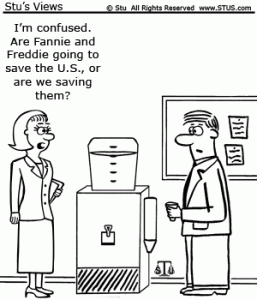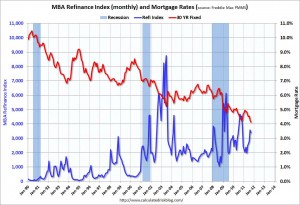It is no stretch to say that Friday, September 2 was the most significant day for mortgage crisis litigation since the onset of the crisis in 2007. That Friday, the Federal Housing Finance Agency (FHFA), as conservator for Fannie Mae and Freddie Mac, sued almost all of the world’s largest banks in 17 separate lawsuits, covering mortgage backed securities with original principal balances of roughly $200 billion. Unless you’ve been hiking in the Andes over the last two weeks, you have probably heard about these suits in the mainstream media. But here at the Subprime Shakeout, I like to dig a bit deeper. The following is my take on the most interesting aspects of these voluminous complaints (all available here) from a mortgage litigation perspective.
Throwing the Book at U.S. Banks
The first thing that jumps out to me is the tenacity and aggressiveness with which FHFA presents its cases. In my last post (Number 1 development), I noted that FHFA had just sued UBS over $4.5 billion in MBS. While I noted that this signaled a shift in Washington’s “too-big-to-fail” attitude towards banks, my biggest question was whether the agency would show the same tenacity in going after major U.S. banks. Well, it’s safe to say the agency has shown the same tenacity and then some.
FHFA has refrained from sugar coating the banks’ alleged conduct as mere inadvertence, negligence, or recklessness, as many plaintiffs have done thus far. Instead, it has come right out and accused certain banks of out-and-out fraud. In particular, FHFA has levied fraud claims against Countrywide (and BofA as successor-in-interest), Deutsche Bank, J.P. Morgan (including EMC, WaMu and Long Beach), Goldman Sachs, Merrill Lynch (including First Franklin as sponsor), and Morgan Stanley (including Credit Suisse as co-lead underwriter). Besides showing that FHFA means business, these claims demonstrate that the agency has carefully reviewed the evidence before it and only wielded the sword of fraud against those banks that it felt actually were aware of their misrepresentations.
Further, FHFA has essentially used every bit of evidence at its disposal to paint an exhaustive picture of reckless lending and misleading conduct by the banks. To support its claims, FHFA has drawn from such diverse sources as its own loan reviews, investigations by the SEC, congressional testimony, and the evidence presented in other lawsuits (including the bond insurer suits that were also brought by Quinn Emanuel). Finally, where appropriate, FHFA has included successor-in-interest claims against banks such as Bank of America (as successor to Countrywide but, interestingly, not to Merrill Lynch) and J.P. Morgan (as successor to Bear Stearns and WaMu), which acquired potential liability based on its acquisition of other lenders or issuers and which have tried and may in the future try to avoid accepting those liabilities. In short, FHFA has thrown the book at many of the nation’s largest banks.
FHFA has also taken the virtually unprecedented step of issuing a second press release after the filing of its lawsuits, in which it responds to the “media coverage” the suits have garnered. In particular, FHFA seeks to dispel the notion that the sophistication of the investor has any bearing on the outcome of securities law claims – something that spokespersons for defendant banks have frequently argued in public statements about MBS lawsuits. I tend to agree that this factor is not something that courts should or will take into account under the express language of the securities laws.
 The agency’s press release also responds to suggestions that these suits will destabilize banks and disrupt economic recovery. To this, FHFA responds, “the long-term stability and resilience of the nation’s financial system depends on investors being able to trust that the securities sold in this country adhere to applicable laws. We cannot overlook compliance with such requirements during periods of economic difficulty as they form the foundation for our nation’s financial system.” Amen.
The agency’s press release also responds to suggestions that these suits will destabilize banks and disrupt economic recovery. To this, FHFA responds, “the long-term stability and resilience of the nation’s financial system depends on investors being able to trust that the securities sold in this country adhere to applicable laws. We cannot overlook compliance with such requirements during periods of economic difficulty as they form the foundation for our nation’s financial system.” Amen.
This response to the destabilization argument mirrors statements made by Rep. Brad Miller (D-N.C.), both in a letter urging these suits before they were filed and in a conference call praising the suits after their filing. In particular, Miller has said that failing to pursue these claims would be “tantamount to another bailout” and akin to an “indirect subsidy” to the banking industry. I agree with these statements – of paramount importance in restarting the U.S. housing market is restoring investor confidence, and this means respecting contract rights and the rule of law. If investors are stuck with a bill for which they did not bargain, they will be reluctant to invest in U.S. housing securities in the future, increasing the costs of homeownership for prospective homeowners and/or taxpayers.
You can find my recent analysis of Rep. Miller’s initial letter to FHFA here under Challenge No. 3. The letter, which was sent in response to the proposed BofA/BoNY settlement of Countrywide put-back claims, appears to have had some influence.
Are Securities Claims the New Put-Backs?
The second thing that jumps out to me about these suits is that FHFA has entirely eschewed put-backs, or contractual claims, in favor of securities law, blue sky law, and tort claims. This continues a trend that began with the FHLB lawsuits and continued through the recent filing by AIG of its $10 billion lawsuit against BofA/Countrywide of plaintiffs focusing on securities law claims when available. Why are plaintiffs such as FHFA increasingly turning to securities law claims when put-backs would seem to benefit from more concrete evidence of liability?
One reason may be the procedural hurdles that investors face when pursuing rep and warranty put-backs or repurchases. In general, they must have 25% of the voting rights for each deal on which they want to take action. If they don’t have those rights on their own, they must band together with other bondholders to reach critical mass. They must then petition the Trustee to take action. If the Trustee refuses to help, the investor may then present repurchase demands on individual loans to the originator or issuer, but must provide that party with sufficient time to cure the defect or repurchase each loan before taking action. Only if the investor overcomes these steps and the breaching party fails to cure or repurchase will the investor finally have standing to sue.
All of those steps notwithstanding, I have long argued that put-back claims are strong and valuable because once you overcome the initial procedural hurdles, it is a fairly straightforward task to prove whether an individual loan met or breached the proper underwriting guidelines and representations. Recent statistical sampling rulings have also provided investors with a shortcut to establishing liability – instead of having to go loan-by-loan to prove that each challenged loan breached reps and warranties, investors may now use a statistically significant sample to establish the breach rate in an entire pool.
So, what led FHFA to abandon the put-back route in favor of filing securities law claims? For one, the agency may not have 25% of the voting rights in all or even a majority of the deals in which it holds an interest. And due to the unique status of the agency as conservator and the complex politics surrounding these lawsuits, it may not have wanted to band together with private investors to pursue its claims.
Another reason may be that the FHFA has had trouble obtaining loan files, as has been the case for many investors. These files are usually necessary before even starting down the procedural path outlined above, and servicers have thus far been reluctant to turn these files over to investors. But this is even less likely to be the limiting factor for FHFA. With subpoena power that extends above and beyond that of the ordinary investor, the government agency may go directly to the servicers and demand these critical documents. This they’ve already done, having sent 64 subpoenas to various market participants over a year ago. While it’s not clear how much cooperation FHFA has received in this regard, the numerous references in its complaints to loan level reviews suggest that the agency has obtained a large number of loan files. In fact, FHFA has stated that these lawsuits were the product of the subpoenas, so they must have uncovered a fair amount of valuable information.
Thus, the most likely reason for this shift in strategy is the advantage offered by the federal securities laws in terms of the available remedies. With the put-back remedy, monetary damages are not available. Instead, most Pooling and Servicing Agreements (PSAs) stipulate that the sole remedy for an incurable breach of reps and warranties is the repurchase or substitution of that defective loan. Thus, any money shelled out by offending banks would flow into the Trust waterfall, to be divided amongst the bondholders based on seniority, rather than directly into the coffers of FHFA (and taxpayers). Further, a plaintiff can only receive this remedy on the portion of loans it proves to be defective. Thus, it cannot recover its losses on defaulted loans for which no defect can be shown.
In contrast, the securities law remedy provides the opportunity for a much broader recovery – and one that goes exclusively to the plaintiff (thus removing any potential freerider problems). Should FHFA be able to prove that there was a material misrepresentation in a particular oral statement, offering document, or registration statement issued in connection with a Trust, it may be able to recover all of its losses on securities from that Trust. Since a misrepresentation as to one Trust was likely repeated as to all of an issuers’ MBS offerings, that one misrepresentation can entitle FHFA to recover all of its losses on all certificates issued by that particular issuer.
The defendant may, however, reduce those damages by the amount of any loss that it can prove was caused by some factor other than its misrepresentation, but the burden of proof for this loss causation defense is on the defendant. It is much more difficult for the defendant to prove that a loss was caused by some factor apart from its misrepresentation than to argue that the plaintiff hasn’t adequately proved causation, as it can with most tort claims.
Finally, any recovery is paid directly to the bondholder and not into the credit waterfall, meaning that it is not shared with other investors and not impacted by the class of certificate held by that bondholder. This aspect alone makes these claims far more attractive for the party funding the litigation. Though FHFA has not said exactly how much of the $200 billion in original principal balance of these notes it is seeking in its suits, one broker-dealer’s analysis has reached a best case scenario for FHFA of $60 billion flowing directly into its pockets.
There are other reasons, of course, that FHFA may have chosen this strategy. Though the remedy appears to be the most important factor, securities law claims are also attractive because they may not require the plaintiff to present an in-depth review of loan-level information. Such evidence would certainly bolster FHFA’s claims of misrepresentations with respect to loan-level representations in the offering materials (for example, as to LTV, owner occupancy or underwriting guidelines), but other claims may not require such proof. For example, FHFA may be able to make out its claim that the ratings provided in the prospectus were misrepresented simply by showing that the issuer provided rating agencies with false data or did not provide rating agencies with its due diligence reports showing problems with the loans. One state law judge has already bought this argument in an early securities law suit by the FHLB of Pittsburgh. Being able to make out these claims without loan-level data reduces the plaintiff’s burden significantly.
Finally, keep in mind that simply because FHFA did not allege put-back claims does not foreclose it from doing so down the road. Much as Ambac amended its complaint to include fraud claims against JP Morgan and EMC, FHFA could amend its claims later to include causes of action for contractual breach. FHFA’s initial complaints were apparently filed at this time to ensure that they fell within the shorter statute of limitations for securities law and tort claims. Contractual claims tend to have a longer statute of limitations and can be brought down the road without fear of them being time-barred (see interesting Subprime Shakeout guest post on statute of limitations concerns.
Predictions
Since everyone is eager to hear how all this will play out, I will leave you with a few predictions. First, as I’ve predicted in the past, the involvement of the U.S. Government in mortgage litigation will certainly embolden other private litigants to file suit, both by providing political cover and by providing plaintiffs with a roadmap to recovery. It also may spark shareholder suits based on the drop in stock prices suffered by many of these banks after statements in the media downplaying their mortgage exposure.
Second, as to these particular suits, many of the defendants likely will seek to escape the harsh glare of the litigation spotlight by settling quickly, especially if they have relatively little at stake (the one exception may be GE, which has stated that it will vigorously oppose the suit, though this may be little more than posturing). The FHFA, in turn, is likely also eager to get some of these suits settled quickly, both so that it can show that the suits have merit with benchmark settlements and also so that it does not have to fight legal battles on 18 fronts simultaneously. It will likely be willing to offer defendants a substantial discount against potential damages if they come to the table in short order.
Meanwhile, the banks with larger liability and a more precarious capital situation will be forced to fight these suits and hope to win some early battles to reduce the cost of settlement. Due to the plaintiff-friendly nature of these claims, I doubt many will succeed in winning motions to dismiss that dispose entirely of any case, but they may obtain favorable evidentiary rulings or dismissals on successor-in-interest claims. Still, they may not be able to settle quickly because the price tag, even with a substantial discount, will be too high.
On the other hand, trial on these cases would be a publicity nightmare for the big banks, not to mention putting them at risk a massive financial wallop from the jury (fraud claims carry with them the potential for punitive damages). Thus, these cases will likely end up settling at some point down the road. Whether that’s one year or four years from now is hard to say, but from what I’ve seen in mortgage litigation, I’d err on the side of assuming a longer time horizon for the largest banks with the most at stake.






